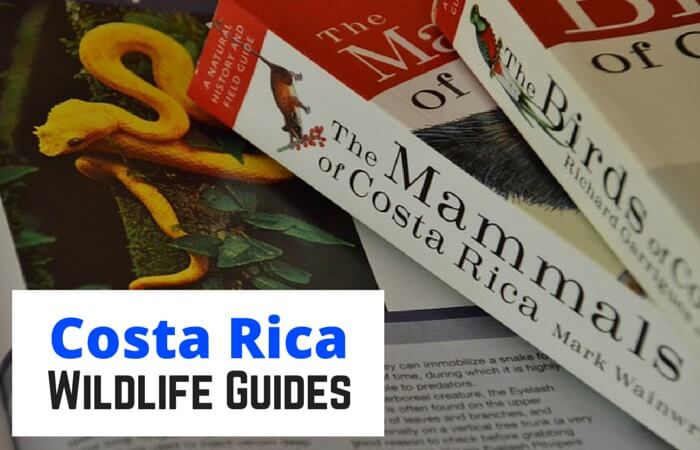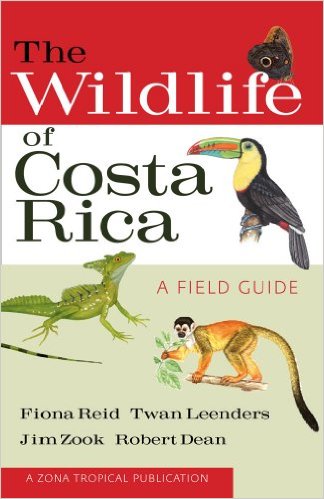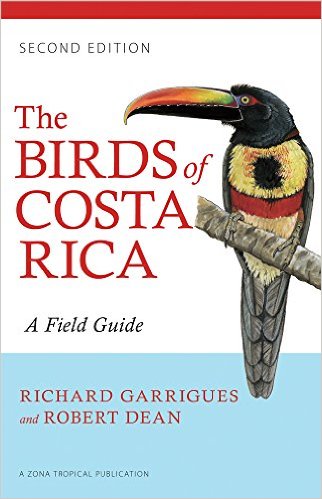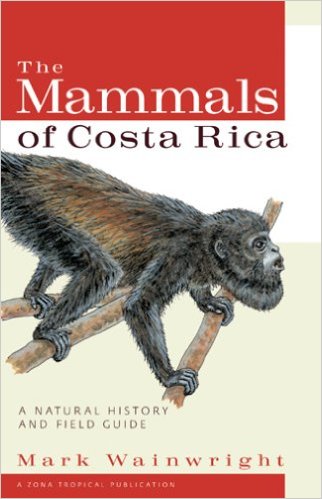
One thing that continuously amazes us about Costa Rica is the amount of biodiversity packed into this small country. Even after living here for over two years, we still discover new creatures out on the trail and enjoy learning more about the ones that live in our backyard. In this post, we share a few of our must-have guides for identifying wildlife.
The Wildlife of Costa Rica: A Field Guide
This was the first wildlife reference guide that we purchased when we became obsessed with Costa Rica and its wildlife. After visiting several times, we found ourselves wanting to know just what makes a two-toed sloth different from the three-toed variety and how howler monkeys differ from white-faced capuchins, squirrel monkeys, and spider monkeys. This book turned out to be a great resource.
The Wildlife of Costa Rica is broken up into five sections: Mammals, Birds, Reptiles, Amphibians, and Arthropods. One of the best things about the book is that it focuses on the most commonly seen wildlife as well as some of the harder to find species on everyone’s wish list (think jaguars and poison-dart frogs). In total, there are 74 mammal species, 226 birds, 61 reptiles, 46 amphibians, and 47 arthropods covered within the pages. Each species has a colored illustration and fairly detailed text that describes its appearance and tells you where the animal lives, what it eats, and a few interesting facts about its behavior.
For the longest time, we used this book alone to identify what we were seeing while out exploring. More recently, in the last year or so, we’ve found ourselves coming across some less common species and wanted to learn more about those as well. The next two books we’ll talk about are from the same publisher and go into more detail. They also include a more robust list of species, so if you are looking to do some serious birding or wildlife viewing, keep on reading.
The Wildlife of Costa Rica (Paperback): $18.84 on Amazon
The Birds of Costa Rica: A Field Guide
Are we bird geeks? Yes. The day we realized that we had incorrectly identified the Golden-naped Woodpecker as the Black-cheeked Woodpecker is the day that we knew we needed a more detailed field guide. All joking aside though, the more time we spend in Costa Rica, the more we have enjoyed birding as a hobby. To look out the window and see a flash of color that you’ve never seen before or to visit a different area of the country and see a bird that only lives there is somehow very exciting. It is also very challenging. And that is where The Birds of Costa Rica has been so helpful.
While The Wildlife of Costa Rica depicts an impressive 226 species of birds, The Birds of Costa Rica has over 903! Besides the much wider coverage, the biggest help in our opinion are the range maps. These maps are given for just about every bird in the book and highlight on a small colored map where the birds are known to live. Out on the trail this makes identification so much faster. If you see a trogon with a yellow belly, for example, a quick glance at the page will show you the three types of yellow-bellied trogons. A look at the maps will then help you narrow down which one it is based on where you are currently birding. If you are in Guanacaste, you can eliminate the Black-throated Trogon because it doesn’t range in that area and decide whether you are seeing the Black-headed or Gartered Trogon.
Additionally, the book has detailed descriptions that really help if you’re still not sure of the exact species. The problem is that sometimes two birds that are completely unrelated look alike, especially to a novice’s eye. To help with that, the authors cross-reference the similar-looking bird so you can go take a look. They also explain what physical differences set them apart (one has wing bars or a striped crown, for example). This lets you compare the two descriptions and illustrations to make the correct identification.
As for the illustrations, one challenge with this book are the colored drawings. While they are gorgeous works of art, sometimes it is impossible to match the colors of ink to the colors you see in the wild. Plus, there may be subtle distinctions in coloring regionally, making it difficult to get the shade just right. When this is the case, we sometimes have to do a quick online search for a photo to help us confirm what we are seeing. All in all though, this book is outstanding and we highly recommend it for serious bird lovers like us.
The Birds of Costa Rica (Paperback): $22.19 on Amazon
The Mammals of Costa Rica: A Natural History and Field Guide
If you are the type of person who loves to watch nature programs on TV, then you will find hours of entertainment in The Mammals of Costa Rica. This book gathers information that was previously available only in complex scientific papers and presents it in an easy to read, enjoyable format.
The Mammals of Costa Rica is the kind of book that we keep at home and enjoy reading with a cup of coffee or before dozing off in bed. It is heavy, at over 400 pages, and a little too descriptive for our purposes to carry on the trail, but still one of our favorite resources. Coming home after a hike and reading in depth about the animals we just saw definitely gives us a greater appreciation for them and we always learn something interesting. Did you know that spider monkeys have the strongest prehensile tail of any mammal in the world and that they can use it to grab fruit or scoop water? These are some of the cool facts you will pick up from this book.
Like The Birds of Costa Rica, this book also has great illustrations and range maps for each species. We also like that the author includes drawings of the animal tracks and scat since we always photograph tracks that we see out in the forest. The book does a thorough job describing each family (e.g., bats, weasels, monkeys, cats) too, including their distribution in the world and Costa Rica, how they have evolved, things like body design and skeletal features, as well as conservation information. For people who love animals and love to absorb knowledge, this book is a keeper.
The Mammals of Costa Rica (Paperback): $20.24 on Amazon
* * *
So there are our three go-to wildlife guides for Costa Rica. These books hardly ever collect any dust as we are always looking up some strange insect or trying to identify a bird that we’ve never seen before. And that is the great thing about Costa Rica, there is always something new to discover.
Do you keep any of these books in your pack? Let us know in the comments below.
Some of the links in this post are connected to affiliate programs we have joined. If you make a purchase using one of the links, we get a small commission. This doesn’t cost you anything extra and helps us keep providing information on this website for free. Thanks for your support!
Looking for some wildlife hot spots in Costa Rica? Check out these destinations:
- Tortuguero: Off the Resort – Set on Costa Rica’s Caribbean coast, this is one of the best places to witness sea turtles laying their eggs. It also has a ton of other wildlife within its jungle and wetlands.
- Drake Bay: Costa Rica Unplugged – Located on the remote Osa Peninsula, this is one of the best jumping off points to see Corcovado National Park and all its majestic wildlife. We saw our first Baird’s Tapir, Central America’s largest land mammal, on a day trip to the park.
- Manuel Antonio Trip Planning – This beach destination has one of the most popular national parks in the country, and animals like sloths and monkeys are known to hang from trees all around town.




